Rockets, Radar, and Computers: The International Geophysical Year
The 1957-1958 International Geophysical Year (IGY) was an international effort to coordinate the collection of geophysical data from around the world. It marked the beginning of a new era of scientific discovery at a time when many innovative technologies were appearing. The IGY still lives today in many NOAA programs, databases, and participation in international collaborations. Not only does 2007 mark NOAA's 200th anniversary, it is also the 50th anniversary of the IGY.
- Introduction
- The 18-Month Year
- The IGY, Science, & Public
- The IGY's Legacy at NOAA
- Conclusion
- Works Consulted

The solar corona, which produces solar wind, is evident in this eclipse. Click image for larger view.
On April 5, 1950, in Silver Spring, Maryland, a small group of scientists gathered to meet with Sydney Chapman, a visiting scientist from England. The men, all geophysicists, were there to discuss Chapman's latest theories on Earth's atmosphere.
The conversation turned to geophysics, including the complexity of Earth's oceans and atmosphere, geodesy, geomagnetism, and the role of the sun in Earth processes. Someone suggested that with all the new tools now available, such as rockets, radar, and computers, perhaps it was time for a coordinated, worldwide study of Earth's systems.
That evening, these scientists planted the seeds of what would eventually be called the International Geophysical Year (IGY). Twenty years later, in 1970, the scientific disciplines emphasized during the IGY would be the foundation of many of NOAA's programs and activities. The IGY was a significant event in the history of science.
IGY: The Year that Lasted 18 Months
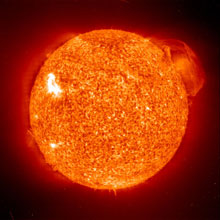
Scientists studied solar phenomena extensively during the International Geophysical Year. Click image for larger view.
Scientists timed the IGY to coincide with an expected peak of sunspot activity and several eclipses. An 18-month long IGY would allow scientists to sample all of these solar events, as well as conduct other timely research. So, the International Council of Scientific Unions designated July 1, 1957 through December 31, 1958, as the IGY.
In the seven years leading up to the IGY, scientists planned and carried out many pre-IGY test events. Various international scientific organizations joined the planning process, and planners invited many nations to propose scientific projects. A permanent research station in the Antarctic was built. Scientists designed and built precise instruments, as well as rockets and balloons that would carry these instruments into the atmosphere and space. Technology first developed during World War II was adapted for peaceful purposes.
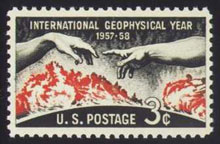
A stamp released by the United States during the 1957-1958 International Geophysical Year.
The IGY was not unprecedented. There were International Polar Years in 1882 and 1932. During the 1932 Polar Year, several "new" technologies, such as precision cameras and high-frequency radio, were used for data collection. Although the 1932 Polar Year accomplished many of its goals, it fell short on others because of the advance of World War II. In fact, because of the war, much of the data collected and scientific analyses completed during the 1932 Polar Year were lost forever.
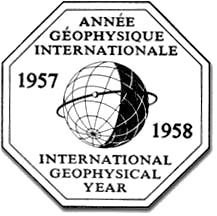
The official logo of the 1957-1958 International Geophysical Year.
The World Data Centers Are Created
The potential loss of data to war and politics was particularly troubling to the IGY organizing committee. The committee resolved that "all observational data shall be available to scientists and scientific institutions in all countries." They felt that without the free exchange of data across international borders, there would be no point in having an IGY.
In April 1957, just three months before the IGY began, scientists representing the various disciplines of the IGY established the World Data Center system. The United States hosted World Data Center "A" and the Soviet Union hosted World Data Center "B." World Data Center "C" was subdivided among countries in Western Europe, Australia, and Japan. Today, NOAA hosts seven of the fifteen World Data Centers in the United States.
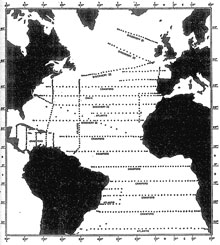
The British-American survey of the Atlantic, carried out between September 1954 and July 1959, was a major contribution to the IGY. Each dot represents a point where data were collected on ocean temperature, salinity, oxygen content, and dissolved chemicals. Click image for larger view.
Each World Data Center would eventually archive a complete set of IGY data to deter losses prevalent during the International Polar Year of 1932. Each World Data Center was equipped to handle many different data formats, including computer punch cards and tape—the original computer media. In addition, each host country agreed to abide by the organizing committee’s resolution that there should be a free and open exchange of data among nations.
Down to Business
Sixty-seven countries and more than 4,000 research stations participated in the IGY. Their efforts were concentrated in the Polar Regions, along the equator, and along several geographic lines joining Pole to Pole. One line went through Europe and Africa, another through the Americas, and the third through East Asia and Australia.
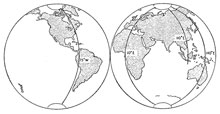
The three chief meridians (i.e., Pole-to-Pole geographic lines) where IGY research stations took measurements, plus a fourth for additional coverage of the Soviet Union and Southeast Asia. Click image for larger view and image credit.
The IGY included projects in 11 Earth sciences, including geomagnetism, glaciology, gravity, ionospheric physics, precision mapping, meteorology, oceanography, seismology, solar activity, and others. Data flowed into the World Data Centers, duplicated according to plan. There was collaboration among nations. International politics remained on the sidelines.
The Space Race Begins
However, everything changed on October 4, 1957, when the Soviet Union launched Sputnik, the first Earth satellite. Although the launching of Sputnik was a planned part of the IGY, Soviets launched the satellite using a military intercontinental ballistic missile. This went against plans to use non-military rocket and satellite designs and deployments to collect data during the IGY.The IGY, Science, and the Public

"What was that?" was a cartoon reaction to the launch of Sputnik I by Thomas Flannery of the Baltimore Sun.
The Sputnik "crisis" overshadowed the other activities of the IGY, because the public was unaware that satellite launches were a planned activity of the IGY. Instead, Americans responded to Sputnik's launch with fear and even panic. What will the Soviets do next? Why are American scientists so far behind in this technology?
What the public did not know was that in academia and scientific circles, the Sputnik launch was applauded as a breakthrough event in healthy scientific competition. Launches by other countries would follow. It was not until the IGY was over that the public learned of the benefits of the extensive international scientific cooperation. Those from different scientific disciplines that once worked in isolation found common ground and new paths to invention. Eventually, the public began to see the benefits of these scientific endeavors in their daily lives.
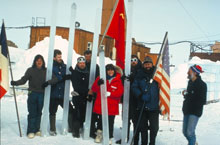
A 1990s international team of scientists poses with the ice cores they were studying at Vostok Station, a former IGY research station, in Antarctica. Click image for larger view.
During the IGY, there were many accomplishments. For example, scientists defined the mid-ocean ridges (furthering understanding of the Earth's crust and plate tectonics), discovered the Van Allen radiation belts, launched the first artificial satellite (Sputnik I), charted ocean depths and ocean currents, studied Earth's magnetic field, measured upper atmospheric winds, studied the Antarctic in great detail, and set the stage for further international cooperation in geophysical research.
The IGY's Legacy at NOAA

An artist's rendition of the geomagnetic field around Earth. Click image for larger view and image credit.
In the end, the IGY was a resounding success. In some fields, data collection was incomplete, and so informal extensions were added and new cooperative efforts were forged.
NOAA was not yet an agency in the late 1950s, but many of the activities of the IGY and post-IGY period are alive at NOAA today. NOAA research and data collection continue in IGY disciplines such as space weather, geomagnetism, glaciology, gravity, precision mapping, meteorology, oceanography, seismology, and solar activity.
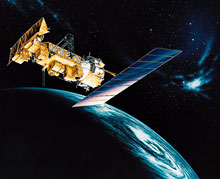
The NOAA-M is a polar-orbiting operational environmental satellite managed and maintained by NOAA. Click image for larger view.
NOAA continued the IGY's original goal of launching non-military, Earth-observing satellites. NOAA now operates the nation's civilian geostationary and polar-orbiting environmental satellites. Scientists use data streams from these observing systems for research, predictions, and forecasting.
The World Data Centers, created as repositories for data collected during the IGY, still exist today. Seven of the 15 World Data Centers in the United States are co-located at NOAA National Data Centers or at NOAA affiliates. These Data Centers not only preserve historical data, but also promote research and ongoing data collection.
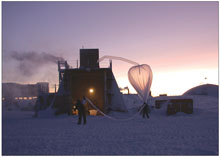
NOAA scientists and collaborators take measurements of ozone levels at sunrise at Amundsen South Pole Station in 2003. Click image for larger view.
The spirit of the IGY lives on in NOAA's continued participation in collaborative international scientific endeavors. For example, many countries, including the United States, are currently collaborating on the development of a "Global Earth Observation System," or GEOSS. The goal of GEOSS is to leverage the latest in technology and integrate worldwide data for the benefit of Earth's inhabitants. Sixty countries, the European Commission, and more than 40 international organizations are supporting this effort.
Conclusion
The IGY led to several advancements that live on today. For example, the work of the IGY led directly to the Antarctic Treaty, which called for the use of Antarctica for peaceful purposes and cooperative scientific research. Since then, international cooperation has led to protecting the Antarctic environment, preserving historic sites, and conserving the animals and plants. Today, 41 nations have signed the Treaty and international collaborative research continues.
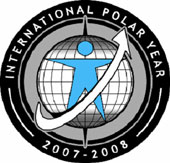
This is the logo for the fourth International Polar Year, which will take place in 2007-2008.
The fourth International Polar Year will be in 2007-2008 and will focus on climate change and its effects on the polar environment. Sixty countries will participate in this effort and it will include studies in the Arctic and Antarctic. NOAA will be fully participating.
In 2007, NOAA is celebrating two momentous anniversaries—the 200th anniversary of NOAA's founding and the 50th anniversary of the IGY.
Works Consulted
Fraser, Ronald. (1957). Once Round the Sun: The Story of the International Geophysical Year, 1957-58. London, England: Hodder and Stroughton Limited.
Sullivan, Walter. (1961). Assault on the Unknown: The International Geophysical Year. New York, New York: McGraw-Hill Book Company.
Wilson, J. Tuzo. (1961). IGY: The Year of the New Moons. New York, New York: Alfred A. Knopf, Inc.
